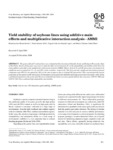Please use this identifier to cite or link to this item:
http://www.alice.cnptia.embrapa.br/alice/handle/doc/1034753| Title: | Yield stability of soybean lines using additive main effects and multiplicative interaction analysis - AMMI. |
| Authors: | ROCHA, M. de M.  VELLO, N. A.   LOPES, Â. C. de A.   MAIA, M. C. C.   |
| Affiliation: | MAURISRAEL DE MOURA ROCHA, CPAMN; NATAL ANTONIO VELLO, Escola Superior de Agricultura "Luiz de Queiroz", Universidade de São Paulo; ÂNGELA CELIS DE ALMEIDA LOPES, UFPI; MARIA CLIDEANA CABRAL MAIA, Escola Superior de Agricultura “Luiz de Queiroz”, Universidade de São Paulo. |
| Date Issued: | 2004 |
| Citation: | Crop Breeding and Applied Biotechnology, Viçosa, MG, v. 4, n. 4, p. 391-398, Dec. 2004. |
| Description: | The grain yield of 27 soyabean lines was evaluated at 3 locations (Anhembi, Areao and Esalq) in Piracicaba, Sao Paulo, Brazil, during 4 crop years (1996/97-1999/2000) to study the effect of environment (E) on the adaptability and stability of the lines (G) using additive main effects and multiplicative interaction analysis. Effects of G, E, and GE interaction were significant and accounted for 51, 12, and 36% of the variation, respectively. The first and only significant interaction principal component axis accounted for 26% of the sum of squares due to original GE interaction. This concentrated the largest proportion of the pattern of GE interaction. Environments associated with Anhembi and Esalq proved more favourable, while Areao contributed negatively to the grain yield. However, Anhembi and Areao were more predictable for the crop years. USP 93-5082 and USP 93-5243 lines combined high adaptability and stability. |
| Thesagro: | Glycine Max Soja |
| Keywords: | Interação GE Previsibilidade AMMI model GE Interaction Predictability |
| Type of Material: | Artigo de periódico |
| Access: | openAccess |
| Appears in Collections: | Artigo em periódico indexado (CPAMN)  |
Files in This Item:
| File | Description | Size | Format | |
|---|---|---|---|---|
| CBABV4N4.pdf | 100,71 kB | Adobe PDF |  View/Open |









